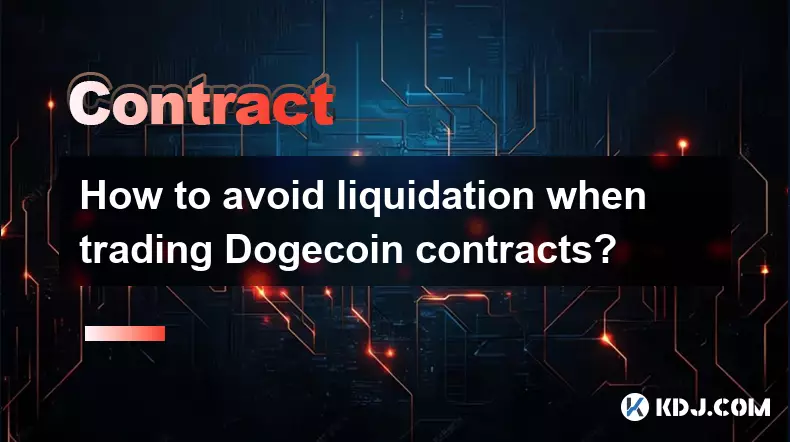-
 bitcoin
bitcoin $124586.364639 USD
0.62% -
 ethereum
ethereum $4670.671710 USD
3.33% -
 xrp
xrp $2.983701 USD
0.18% -
 tether
tether $1.000175 USD
-0.03% -
 bnb
bnb $1209.430642 USD
2.76% -
 solana
solana $231.365861 USD
0.51% -
 usd-coin
usd-coin $0.999665 USD
-0.02% -
 dogecoin
dogecoin $0.264657 USD
4.46% -
 tron
tron $0.346415 USD
1.60% -
 cardano
cardano $0.871586 USD
3.70% -
 chainlink
chainlink $23.451270 USD
7.56% -
 hyperliquid
hyperliquid $46.860071 USD
-2.96% -
 ethena-usde
ethena-usde $1.000120 USD
0.04% -
 sui
sui $3.611279 USD
1.08% -
 stellar
stellar $0.407149 USD
0.96%
How to avoid liquidation when trading Dogecoin contracts?
Liquidation in Dogecoin futures occurs when margin falls below maintenance levels, often due to high volatility and leverage—exchanges close positions automatically, resulting in total loss of initial margin.
Oct 04, 2025 at 11:18 pm

Understanding Liquidation in Dogecoin Futures Trading
1. Liquidation occurs when a trader’s margin balance falls below the maintenance threshold required to keep a leveraged position open. In Dogecoin contract trading, this often happens due to high volatility and sudden price swings. When liquidation takes place, the exchange automatically closes the position to prevent further losses, resulting in the total loss of the initial margin.
2. The risk of liquidation increases with higher leverage. While 50x or 100x leverage can amplify gains, it also dramatically reduces the buffer against adverse price movements. A minor shift in Dogecoin’s price—often less than 2% at high leverage—can trigger a forced exit from the trade.
3. Funding rates in perpetual Dogecoin contracts also play a role. Holding positions over extended periods may lead to continuous funding payments, which slowly erode margin levels and bring traders closer to liquidation even without significant price changes.
4. Market depth and slippage are critical factors. During high-impact news or whale movements, Dogecoin’s order book may thin out rapidly, causing executed prices to deviate sharply from expected levels. This discrepancy can accelerate margin depletion and increase liquidation risk.
5. Exchanges calculate liquidation prices based on entry price, leverage, and current mark price. Traders who fail to monitor these metrics in real time often find themselves caught off guard when their positions are closed.
Strategies to Reduce Liquidation Risk
1. Use lower leverage to create a larger safety margin. Instead of maxing out at 100x, opting for 10x or 20x allows room for price fluctuations without immediate liquidation. This conservative approach preserves capital during volatile swings common in meme coin markets.
2. Set stop-loss orders strategically below key support levels for longs or above resistance for shorts. These act as automatic exits before margin drops too low, giving traders control over their risk exposure rather than relying solely on exchange mechanisms.
3. Monitor your wallet balance and margin ratio continuously. Many trading platforms offer alerts when margin levels approach danger zones. Reacting early by adding margin or reducing position size can prevent automatic liquidation.
4. Diversify position entries through scaling instead of deploying full capital at once. By entering trades in smaller batches, traders reduce the impact of poor entry timing and maintain flexibility to adjust under pressure.
5. Avoid holding large positions during major events such as Elon Musk tweets, exchange listings, or macroeconomic announcements. Dogecoin is highly sentiment-driven, and unpredictable spikes or crashes can obliterate margin buffers within seconds.
Optimizing Position Management Techniques
1. Calculate your liquidation price manually using available formulas or online calculators. Knowing exactly where your position will be closed helps determine whether the current market structure supports your trade setup.
2. Adjust position size based on volatility indicators like Bollinger Bands or Average True Range (ATR). During periods of elevated volatility, smaller positions help maintain stability and reduce the likelihood of being wiped out by noise.
3. Utilize partial take-profit exits to secure gains and free up margin. Closing 50% of a winning position locks in profits and lowers the overall risk profile, allowing the remainder to run with reduced pressure.
4. Maintain a reserve of stablecoins specifically for margin top-ups. Having readily available funds enables quick responses to adverse moves without needing to close positions prematurely.
5. Trade only during high-liquidity hours when order books are deep and spreads are tight. Thin markets increase the chance of sudden liquidations triggered by small trades or bots.
Proper risk management is not optional in Dogecoin contract trading—it is essential for survival. Ignoring liquidation mechanics leads to repeated account drawdowns and eventual blow-ups.
Traders who respect volatility, use conservative leverage, and actively manage open positions consistently outperform those chasing quick wins with excessive risk.
Real-time monitoring, disciplined execution, and emotional control form the foundation of sustainable success in high-leverage crypto derivatives trading.
Frequently Asked Questions
What is the safest leverage level for Dogecoin futures?A leverage range of 5x to 15x is generally considered safe for most traders. It balances profit potential with sufficient protection against normal price swings. New traders should start at 5x or lower until they gain experience managing live positions.
Can I recover my funds after a liquidation?No, once a position is liquidated, the margin is lost. Some exchanges charge additional fees during the process. Recovery is only possible through future profitable trades, not from the liquidated amount itself.
How do I check my liquidation price on most platforms?Most derivative exchanges display the liquidation price directly in the position tab. It appears alongside entry price, unrealized PnL, and margin used. Ensure this value has adequate distance from the current market price.
Does increasing my margin reduce the chance of liquidation?Yes, adding more margin increases your collateral, which pushes the liquidation price further away from the current market rate. This provides a larger buffer against adverse moves and improves trade resilience.
Disclaimer:info@kdj.com
The information provided is not trading advice. kdj.com does not assume any responsibility for any investments made based on the information provided in this article. Cryptocurrencies are highly volatile and it is highly recommended that you invest with caution after thorough research!
If you believe that the content used on this website infringes your copyright, please contact us immediately (info@kdj.com) and we will delete it promptly.
- BlockDAG, DOGE, HYPE Sponsorship: Crypto Trends Shaping 2025
- 2025-10-01 00:25:13
- Deutsche Börse and Circle: A StableCoin Adoption Powerhouse in Europe
- 2025-10-01 00:25:13
- BlockDAG's Presale Buzz: Is It the Crypto to Watch in October 2025?
- 2025-10-01 00:30:13
- Bitcoin, Crypto, and IQ: When Genius Meets Digital Gold?
- 2025-10-01 00:30:13
- Stablecoins, American Innovation, and Wallet Tokens: The Next Frontier
- 2025-10-01 00:35:12
- NBU, Coins, and Crypto in Ukraine: A New Yorker's Take
- 2025-10-01 00:45:14
Related knowledge

What is the difference between futures and perpetual contracts for Bitcoin?
Oct 02,2025 at 11:54pm
Understanding Bitcoin Futures Contracts1. Bitcoin futures are derivative instruments that allow traders to speculate on the future price of Bitcoin at...

What is the best time to trade PEPE contracts?
Oct 03,2025 at 11:54am
Understanding PEPE Contract Volatility1. PEPE contracts exhibit extreme price fluctuations due to their meme-based nature and low market cap. Trading ...

What are the common mistakes to avoid with Bitcoincoin contracts?
Oct 03,2025 at 08:54am
Emerging Trends in the Cryptocurrency Market1. Decentralized finance (DeFi) platforms continue to expand their influence across the blockchain ecosyst...

What is the maintenance margin for Bitcoin contracts?
Oct 02,2025 at 01:36am
Decentralized Exchanges Gain Momentum in 20241. Decentralized exchanges (DEXs) have seen a significant rise in trading volume, surpassing centralized ...

How to use technical analysis for trading XRP contracts?
Oct 03,2025 at 01:18pm
Understanding Price Patterns in XRP Futures1. Identifying chart patterns such as triangles, head and shoulders, and double tops or bottoms can provide...

What does "longing" PEPE contracts mean?
Oct 03,2025 at 11:54pm
Understanding Decentralized Exchanges in the Crypto Ecosystem1. Decentralized exchanges (DEXs) operate without a central authority, allowing users to ...

What is the difference between futures and perpetual contracts for Bitcoin?
Oct 02,2025 at 11:54pm
Understanding Bitcoin Futures Contracts1. Bitcoin futures are derivative instruments that allow traders to speculate on the future price of Bitcoin at...

What is the best time to trade PEPE contracts?
Oct 03,2025 at 11:54am
Understanding PEPE Contract Volatility1. PEPE contracts exhibit extreme price fluctuations due to their meme-based nature and low market cap. Trading ...

What are the common mistakes to avoid with Bitcoincoin contracts?
Oct 03,2025 at 08:54am
Emerging Trends in the Cryptocurrency Market1. Decentralized finance (DeFi) platforms continue to expand their influence across the blockchain ecosyst...

What is the maintenance margin for Bitcoin contracts?
Oct 02,2025 at 01:36am
Decentralized Exchanges Gain Momentum in 20241. Decentralized exchanges (DEXs) have seen a significant rise in trading volume, surpassing centralized ...

How to use technical analysis for trading XRP contracts?
Oct 03,2025 at 01:18pm
Understanding Price Patterns in XRP Futures1. Identifying chart patterns such as triangles, head and shoulders, and double tops or bottoms can provide...

What does "longing" PEPE contracts mean?
Oct 03,2025 at 11:54pm
Understanding Decentralized Exchanges in the Crypto Ecosystem1. Decentralized exchanges (DEXs) operate without a central authority, allowing users to ...
See all articles










































































